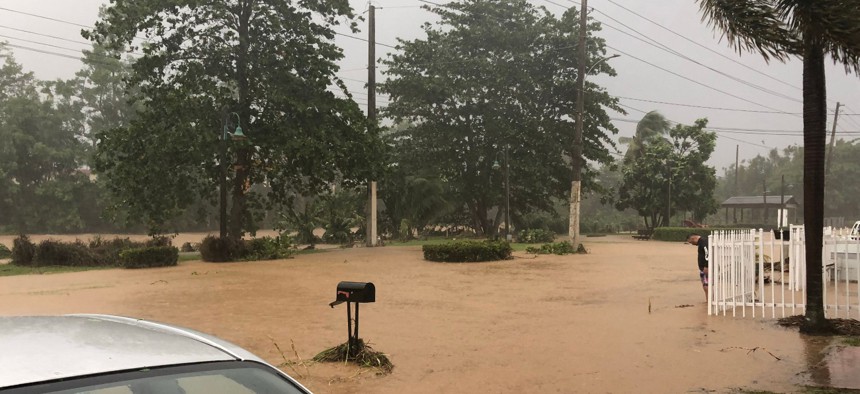
A flooded road during the passage of Hurricane Fiona in Villa Blanca, Puerto Rico, on Sept. 18. The storm left a general blackout and overflowing rivers in its wake. OPM has established an emergency leave transfer program for federal employees impacted by the hurricane. MELVIN PEREIRA/AFP via Getty Images
OPM Approves Multiple Emergency Leave Transfer Programs
A weekly roundup of pay and benefits news.
The Office of Personnel Management has established two emergency leave transfer programs for federal workers in connection with regional disasters within the last week, and another could soon be on the way.
On Sept. 23, OPM Director Kiran Ahuja issued a memo to agency heads announcing the establishment of an emergency leave transfer program for federal employees impacted by the water crisis in Jackson, Miss. For nearly two months, residents lacked access to clean water following severe rain and flooding.
And on Wednesday, she issued another memo establishing a similar leave transfer program for feds impacted by Hurricane Fiona, which struck Puerto Rico and knocked out power for the entire island and damaged homes, roads and bridges.
The leave transfer program for the water crisis covers Hinds, County, Miss., while the program covering Hurricane Fiona covers all 78 municipalities in Puerto Rico. Emergency leave transfer programs allow federal employees to donate unused annual leave to fellow federal workers who have been adversely affected by a disaster or emergency, who may require additional paid time off to recover.
“Employees who are adversely affected and seek to become emergency leave recipients must apply in writing to their agencies,” Ahuja wrote. “An employee who is unable to do so on their own may apply through a personal representative. The [emergency leave transfer program will be in place to assist approved leave recipients as the need for donated annual leave becomes known.”
Individual agencies are responsible for determining how many of their employees require leave through the program and to distribute it to those in need, Ahuja wrote. She encouraged agencies to ensure that those who require donated leave to request it in advance.
“[Agencies should] educate adversely affected employees that, dependent on agency policy, they may request advanced annual or sick leave, as appropriate (even if they have available annual and sick leave) or leave without pay, so that they are not forced to use accrued leave before donated annual leave becomes available,” Ahuja wrote. “This is necessary since donated annual leave may not be retroactively substituted for accrued annual or sick leave used because of the emergency; it may only be substituted retroactively for any period of leave without pay or advanced annual or sick leave used because of the emergency.”
Although agencies are in charge of collecting and distributing donated leave for their employees, OPM can coordinate the donation of leave across multiple agencies, in cases where agencies do not receive sufficient amounts of donated leave to meet demand.
“Based on the demand for donated leave, OPM will solicit and coordinate the transfer of donated leave among federal agencies,” Ahuja wrote. “OPM will notify each agency of the cumulative amount of donated annual leave that will be credited to it for transfer to its approved emergency leave recipients.”
Another emergency leave transfer program is likely on the way, as Hurricane Ian made landfall along the Florida coast as a category 4 storm on Wednesday afternoon, promising 150 mile-per-hour winds and the potential for severe flooding.
NEXT STORY: GovExec Daily: Preparing to 'Win' Retirement



